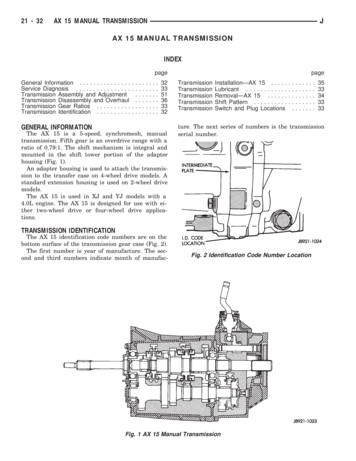
Transcription
Chapter 3 Data TransmissionCSE 32131Data Transmission quality of the signal beingtransmittedThe successfultransmission of datadepends on two factors: characteristics of thetransmission medium21
Transmission TerminologyData transmission occurs between transmitter andreceiver over some transmission medium.Communication isin the form ofelectromagneticwaves.Guided mediatwisted pair,coaxial cable,optical fiberUnguided media(wireless)air, vacuum,seawater3Transmission Terminology (2)42
Transmission Terminology (3) Simplex signals transmitted in one direction eg. television Half duplex both stations transmit, but only one at a time eg. police radio Full duplex simultaneous transmissions eg. telephone5Note: elsewhere, half duplex is called “simplex”;full duplex is called “duplex” (ITU-T definitions)Analog and Digital Data Transmission Data Entities that convey meaning, or information (data info) Signals Electric or electromagnetic representations of data Signaling Physical propagation of the signal along a medium Transmission Communication of data by propagation and processing of signals63
Analog and Digital Data Analog Continuous values within some interval e.g. sound, video Digital Discrete values e.g. text, integers7Analogue and Digital Signals84
Analog Signals9Digital Signals105
Advantages & Disadvantagesof Digital Signals cheaper less susceptible to noise but greater attenuation digital now preferred choice11Frequency, Spectrum and Bandwidth Time domain concepts Analog signal Various in a smooth way over time Digital signal Maintains a constant level then changes to another constant level Periodic signal Pattern repeated over time Aperiodic signal Pattern not repeated over time126
PeriodicSignals13Sine WavePeriodic continuous signal Peak Amplitude (A) maximum strength of signal volts Frequency (f) rate of change of signal Hertz (Hz) or cycles per second period time for one repetition (T) T 1/f Phase (φ) relative position in time147
Examples of Sine Wavess(t) A sin(2πft Φ)15Wavelength (λ)the wavelength of asignal is the distanceoccupied by a singlecycle16can also be stated as thedistance between two pointsof corresponding phase oftwo consecutive cyclesespecially when v c c 3x108 m/s(speed of light in freespace)assuming signal velocity v,then the wavelength isrelated to the period asλ vTor equivalentlyλf v8
Frequency Domain Concepts Signal usually made up of many frequencies Components are sine waves Can be shown (Fourier analysis) that any signal is made up ofcomponents at various frequencies; each component is a sinewave fundamental frequency period of total signal period of fundamental frequency harmonic frequency a multiple of fundamental frequency Can plot frequency domain functions17FrequencyDomainExamplesS(f) is discreteFigure a is discrete becausethe time domain function isperiodic. Figure b iscontinuous because the timedomain function is aperiodic.(a) Frequency domain function for s(t) (4/π)[sin(2πft) (1/3)sin(2π(3f)t)]Single square pulseS(f) is continuous18(b) Frequency domain function for a single square pulse s(t) 1 for -X/2 t X/29
19Addition ofFrequencyComponents(T 1/f)(a) sin(2πft)(c) is the sum of f and 3f(b) (1/3)sin(2π(3f)t)(c) (4/π)[sin(2πft) (1/3)sin(2π(3f)t)]2010
OriginalTime - Harmonic spectrumAs we addmoreharmonicsthe signalreproducesthe originalmore closely21Analog Signalingamplitude (volts) Frequency and peak amplitude are the most important.1 cyclephasedifferencetime(sec)frequency (hertz) cycles per second2211
FrequencyDomainS(f) is discreteFigure a is discrete becausethe time domain function isperiodic. Figure b iscontinuous because the timedomain function is aperiodic.(a) Frequency domain function for s(t) (4/π)[sin(2πft) (1/3)sin(2π(3f)t)]Single square pulseS(f) is continuous23(b) Frequency domain function for a single square pulse s(t) 1 for -X/2 t X/2Spectrum and Bandwidth Spectrum range of frequencies contained in signal Absolute bandwidth width of spectrum Effective bandwidth (or just bandwidth) narrow band of frequencies containing most of the energy DC Component Component of zero frequency No DC component average amplitude 0 DC component is undesirable (avg amplitude 0)2412
Signal with DC Component(a) s(t) 1 (4/π)[Sin(2πft) (1/3)Sin(2π(3f)t)]25Data Rate and Bandwidthany transmissionsystem has a limitedband of st energy infirst fewcomponentsthis limits the data ratethat can be carried onthe transmissionmediumsquare waves haveinfinite componentsand hence aninfinite bandwidthThere is a direct relationship betweendata rate and bandwidth.13
ExampleCase 1:f 1 MHzR ? MbpsB ? MHzCase 2:f ? MHzB 8 MHzR ? MbpsCase 3:f ? MHzB 4 MHzR ? Mbps27Data Rate and Bandwidth (2) Any transmission system has a limited band of frequencies This limits the data rate that can be carried Data rate In bits per second Rate at which data can be communicated Bandwidth In cycles per second, or Hertz Constrained by transmitter and medium Channel: a communication path2814
Data Rate and Bandwidth (4)Consider a square wave Data rate R 2 x f (f: fundamental frequency) Double the bandwidth double the data rate(other things being equal) A given bandwidth can support different data rates (e.g., byremoving the component with the highest frequency).However, it’s harder for the receiver to interpret the receivedsignal if R is high (i.e., more chances for errors).29Data Rate and Bandwidth (5)In general, The greater the bandwidth the higher the data rate The higher the data rate The greater the required effectivebandwidth Keeping the same data rate:Greater bandwidth better quality of the received signal,but greater cost The higher center frequency the higher the potentialbandwidth3015
Transmission Impairments (3.3) Signal received may differ from signal transmitted Analog - degradation of signal quality Digital - bit errors Caused by Attenuation and attenuation distortion Delay distortion Noise31Attenuation Signal strength falls off with distance Solutions: use repeaters, amplifiers Depends on medium Received signal strength: must be enough to be detected must be sufficiently higher than noise to be received without error Attenuation is an increasing function of frequencySolutions: equalization amplifying high frequencies more than low frequencies Less of a problem with digital signals (why?)3216
Attenuation and Delay Distortion33Delay Distortion occurs because propagation velocity of a signal through aguided medium varies with frequency highest velocity near the center frequency various frequency components arrive at different timesresulting in phase shifts between the frequencies particularly critical for digital data since parts of one bit spillover into others causing inter-symbol interference solution: equalization3417
Noiseunwanted signalsinserted betweentransmitter andreceiveris the major limitingfactor incommunicationssystem performance35Categories of NoiseIntermodulation noise36 produced by nonlinearities in thetransmitter, receiver, and/orintervening transmission medium effect is to produce signals at afrequency that is the sum or differenceof the two original frequencies18
Categories of NoiseCrosstalk: a signal from one line is pickedup by another can occur by electricalImpulse Noise: caused by external electromagnetic37interferences noncontinuous, consisting ofirregular pulses or spikes short duration and high amplitude minor annoyance for analog signalsbut a major source of error indigital datacoupling between nearbytwisted pairs or whenmicrowave antennas pick upunwanted signalsThermal (White) Noise Due to thermal agitation of electrons Uniformly distributedN kTB (watts)k Boltzmann’s constant 1.38 x 10-23 J/KT kelvin degrees; B bandwidth in Hz3819
Effect of noiseSignalNoiseLogicThresholdSignal NoiseSampling times0 10 1101 1 01 1 000010 10 1Data ReceivedOriginal dataBit error39Signal to Noise Ratio (SNR) Effect distorts a transmitted signal attenuates a transmitted signal signal-to-noise ratio to quantify noise usually expressed using dBSNRdB 10 log10SNS average signal powerN noise power4020
Channel Capacity (3.4) The maximum rate at which data can betransmitted over a given communication path, orchannel, under given conditions. 4 related factors: data rate, bandwidth, noise, error rate(see next slide). Our goal: get as high a data rate as possible at aparticular limit of error rate for a given bandwidth. The main constraint on achieving this efficiency isnoise.41Channel Capacity (cont.) Data rate In bits per second Rate at which data can be communicated Bandwidth In cycles per second of Hertz Constrained by transmitter and medium Noise Average level of noise over the communication path Error rate Error: 1 becomes 0; 0 becomes 1 At a given noise level, higher data rate higher error rate (Fig3.16)4221
Nyquist Bandwidth Assume noise-free channels Channel bandwidth limits the signal/data rate Given bandwidth B, highest signal rate is 2B: C 2B If rate of signal transmission is 2B then signal with frequenciesno greater than B is sufficient to carry signal rate Given binary signal, data rate supported by B Hz is 2B bps Can be increased by using M signal levels: C 2B log2M however this increases burden on receiver noise and other impairments limit the value of M43Nyquist Bandwidth: ExampleBinary signals B 3,100 Hz C 2B 6,200 bpsMulti-level signal M 8 C 2B log2M 2 x 3100 x 3 18,600 bps Higher bit rate with the same bandwidth Drawback?4422
Shannon Capacity Formula Consider data rate, noise and error rate Higher data rate shortens each bit so burst of noise affects more bits At given noise level, high data rate means higher error rate Capacity C B log2(1 S/R) S/R (signal power)/(noise power) Typically measured at the receiver Assumes only thermal noise much lower rates are achieved in practice due to impulse noise,attenuation distortion, delay distortion, etc. Increase data rate by increasing S? Or increasing B?45decibel (dB) Normal ratio Pout/Pin 1 bel (B) log10(Pout/Pin)(devised by engineers of Bell Telephone Lab, named afterAlexander Graham Bell) 1 decibel (dB) 10 B 10 log10(Pout/Pin) Note: this is dimensionless unit (a ratio) 3 dB doubling of power10 log10(2) 10 x 0.3 3 6 dB 4 times the power4623
Why dB and not simple ratio? Signal strength often falls off exponentially. Net gain/loss in a cascaded path can be calculated withsimple addition/subtraction. Signal to noise ratio (in decibels)SNRdB 10 log10 (signal/noise) Note: “S/R” in the Shannon capacity formula is a normalratio, not dB. See Example 3.6 in the textbook.47Exercises Calculate the thermal noise for an effective noisetemperature of 27oC and a 10 MHz bandwidth. Given a channel for digital signals with a bandwidth of1KHz, is it possible to transmit data at a rate of 6 Kbpsalong this channel? If so, describe a method and anyconditions that must be satisfied. If not, explain why. Repeat the previous problem for a data rate of 1 Kbps4824
Exercises (2)Given a square wave signal represented by the followingFourier series:x(t) cos(2πft) – (1/3)cos(6πft) (1/5)cos(10πft) – (1/7)cos(14πft)The fundamental frequency of the signal is 5 KHz.1. What is the effective bandwidth of the signal?2. What is the data rate supported by the signal? Given a SNR of 20 dB, calculate the capacity of a channelwith a bandwidth of 1 KHz.49Required Reading Chapter 3 Reference: Appendix 3A (decibels)5025
receiverreceiver over some transmission medium. over some transmission medium. Data transmission occurs between transmitter receiver Communication is in the form of electromagnetic waves. Guided media twisted pair, coaxial cable, optical fiber Unguided media (wireless) air, vacuum, seawater 3 Transmission Terminology (2) 4










